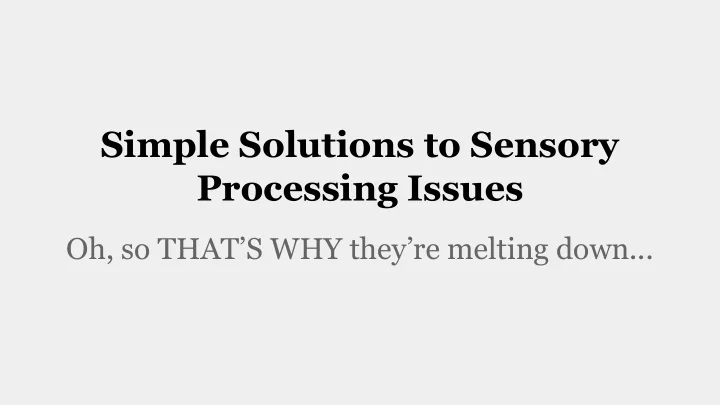

Simple Solutions to Sensory Processing Issues Oh, so THAT’S WHY they’re melting down...
Introductions Cara from Health Home and Happiness Teresa, mom of 11
It’s a sensory issue Sensory avoidant vs Sensory Seeking ● Can have both in the same child ● Many people are only familliar with one kind - ie the seams of socks (sensory avoidant)
Sensory Avoidant Behaviors Visual: Shielding eyes, looking away from contrast (written words), hates bright stores, visual chaos (big box stores, carnivals, Disneyland)
Sensory Avoidant Behaviors Auditory: Dislikes loud noises, hates the vacuum, cannot stand ticking or squeaking in an appliance (this is fairly common), prefers silence
Sensory Avoidant Behaviors Tactile: The famous “seams of the socks” Only will wear elastic waisted pants Will not touch grass with bare feet Dislikes the feel of water, sand, wind Only eats smooth or soft foods Dislikes chips, cookies, carrot sticks
Sensory Seeking Behaviors Visual: Flicking lights off and on Wanting color everywhere Loving Target, Walmart, etc - bright lights Loves flashlights Enjoys patterns and contrast
Sensory Seeking Behaviors Auditory: Verbal stims Listening to the same thing over and over Talking too loud Crashing things down Listening to the TV ‘too loud’
Sensory Seeking Behaviors Tactile: Loves tight hugs Weighted blankets, many blankets Tight clothing Will only wear jeans Smears lotion, makeup, soap Digs in detergent container, sand box, dirt Plays ‘too rough’ Jumps, runs inappropriately
Solutions 1. Identify if your child (or yourself) is seeking/avoidant/neutural in each category a. Visual b. Auditory c. Tactile
Solutions 2. Using the lists from the avoidant/seeking behaviors, come up with appropriate activities that you can work into their day that ‘feed their need’ Aim to give them what they need BEFORE they start to melt down
Solutions: A Sensory Diet Exposure to both desired and undesired sensations helps the brain practice dealing with sensory imput, and provides the sensory activities that kids crave. Don’t focus on making kids do what they don’t want to do, but rather incorporate different textures, pressures, noise levels, and visual stimulation as tolerated . A varied sensory diet is important for these kids to develop and learn to regulate.
Solutions: Appropriate Activities Examples: Visually avoidant - keep lights low at home, provide sunglasses for wearing as often as she wants, avoid ‘big box’ stores, organize and paint room so it is visually minimal Visually seeking - Sharp contrast patterns on walls in room (posters could work), trips to big box stores to help regulate, allow TV to be on but muted for background visual stimulation
Solutions: Appropriate Activities Examples: Auditory Avoidant: Provide ear protection (like is used for shooting), or allow to wear a beanie over her ears. Turn off radio (other people can use headphones) and other unneeded background noise. Warn before turning on appliances. Auditory seeking: Allow to listen to headphones, cap guns, white noise in bedroom at night, (if also sensory seeking) loud music and dancing
Solutions: Appropriate Activities Examples: Sensory Avoidant: Light clothing, avoid wind, keep room warm so they don’t need blankets to sleep, keep shoes and socks on rather than barefoot, clothing without tags, clothing with seams serged flat, soft clothes Sensory Seeking: Swinging high, wrapping like a burrito in a blanket, dry brushing, being tightly hugged for a long time, joint compression (link in notes)
Signs of Sensory Dysregulation ● Melting down ● Extreme highs and lows during play ● Refusal to try new things
Explaining to others “It’s a sensory issue” She’s having a hard time regulating here, discipline won’t help, we need to change her environment. Provide books for grandparents and care providers on Sensory Processing Disorder/ Sensory Integration Dysfunction
Simple Solutions to Sensory Processing Issues Oh, so THAT’S WHY they’re melting down...
Recommend
More recommend